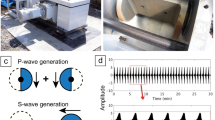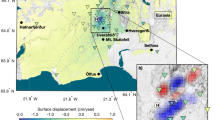Abstract
A NUMBER of workers1 have noted that distant earthquakes are registered on automatic water stage recorders operated on deep wells. In each of these cases, the time scale was so small that the earthquake record was merely a thick line transverse to the direction of time movement. We recently fixed a gauge in a well at Lodi, California, with a Bosch-Omori seismograph drum, rate 15 mm./min., and smoked paper recording. The well is known as 3612A2. It is located at lat. 38° 07 38 N., long. 1217deg; 16 29 W. in the Mokelumne area of the San Joaquin Valley. It is of circular cross section, diameter 6 in., depth 76.0 ft. below ground surface which is at an altitude of 46.9 ft. above mean sea-level. This well, which is not cased below the water surface, is in unconsolidated alluvial deposits of Pleistocene and Pliocene age. It presumably penetrates to a confined aquifer or aquifers. No log is available. The gauge is composed of a copper float, 4J in. in diameter, which operates a stationary 8 in. float-wheel by means of a cord and counterweight. A 4-in. diameter axle mounted on the float-wheel shaft is connected at its upper periphery by a copper ribbon to an auxiliary wheel in the same plane and at the same elevation, on the other side of the recording drum, tension in the ribbon being maintained by a second counterweight below the auxiliary wheel. An aluminium stylus attached to the copper ribbon thus moves horizontally a distance equal to one half that which the float moves vertically. This stylus records on smoked paper on the drum. The minutes are marked on the record by means of a pendulum contact-making clock (supplied by Spindler and Hoyer with Bosch-Omori seismographs), actuating a relay circuit coupled to a solenoid, which energises the magnetic counterweight. Thus the stylus is displaced each minute. The clock correction is obtained daily.
This is a preview of subscription content, access via your institution
Access options
Subscribe to this journal
Receive 51 print issues and online access
$199.00 per year
only $3.90 per issue
Buy this article
- Purchase on Springer Link
- Instant access to full article PDF
Prices may be subject to local taxes which are calculated during checkout
Similar content being viewed by others
References
H. T. Stearns, Bull. 18, Seis. Soc. Amer., pp.9–15, March, 1928; S. B. Morris, paper read before a meeting of Seismological Society of America, Los Angeles, April 8, 1933; A. M. Piper, Trans. Amer. Geophys. Union,April, 1933 meeting, pp.471–475; R. M. Leggette and G. H. Taylor, Earthquake Notes, 6, pp. 16, 17, September, 1934.
Author information
Authors and Affiliations
Rights and permissions
About this article
Cite this article
BYERLY, P., BLANCHARD, F. Well Gauges as Seismographs. Nature 135, 303–304 (1935). https://doi.org/10.1038/135303b0
Issue Date:
DOI: https://doi.org/10.1038/135303b0
Comments
By submitting a comment you agree to abide by our Terms and Community Guidelines. If you find something abusive or that does not comply with our terms or guidelines please flag it as inappropriate.



